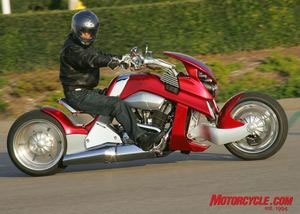Motorcycle Insurance: Comprehensive Collision Coverage

After publishing the second part of this series that discussed Property Damage and Medical Payments, the subject came up in the articles forum thread about the agent getting you to buy the maximum of everything.
Insurance is Vegas without showgirls, was my reply. You pay into the premium, but you are betting on not wrecking or having a claim of any type. The funny thing is that there is a no lose in a sense here. If you pay and make no claim, the house wins (the underwriters in this case). If you have a claim, you win and the house loses. It makes sense doesnt it?
When someone on the forum suggested that I recommend you to purchase the most coverage only to maximize my commission, it made me feel bad that people really dont understand this insurance stuff better. (The following statement does not imply every insurance professional or company endorses the following.)
Insurance agents, brokers and underwriters have a dirty little secret they prefer you not be aware of: They encourage lower limits and high deductibles. Why? Loss ratio. These big underwriters have this business down, and in the motorcycle world, the acceptable loss ratio for most companies is right around 70% of the written premium.
Written premium is the total amount of business I send them in a calendar year. So, if I write $100,000 annual for the largest motorcycle underwriter in the USA and I have $63,000 worth of loss payments between bodily injury and property claims, my loss ratio of 63% is squeaking by the threshold of losing them and me money for the year. If underwriters and agents sell you the higher limits, the faster you will reach the threshold.
Agents can be suspended from writing business if the loss ratio is too high and show no signs of reversal. Its happened with a company I did business with. I actually insure my bike with them but cant write a lick of new business until they get the chip off their shoulder and understand that I cant fix it until I can write something that makes them money, like simple liability policies. It happens. You get used to it in this business. We agents have more at stake than you ever thought, huh? Selling comprehensive and collision coverage just makes the loss ratio move up that much faster.
Comprehensive coverage has deductibles from $0-$1000 usually. Premiums go up when you choose a lower deductible. But theres a limit in change, so ask the difference in price. A great example of this is a dual-sport bike. Its usually just a few dollars of difference between a $500 and $250 deductible for a guy over 25 years of age. So, in this case, pick the low deductible.
If you own a full-blown custom motorcycle worth $35,000 or more, then you could not only afford the financial responsibility of a $1000 deductible, but Id encourage it. Customs are difficult to insure and the rates are usually not far off what some kid on a liter-class sportbike would pay in premium. You might as well keep that premium low.
Whats Comp coverage cover? It covers theft, fire, vandalism and acts of nature. Theft is self-explanatory. Fire insurance covers spontaneous or malicious (by anyone but you or a family member) incidents. I say that because I had a customers wife set his bike ablaze and they denied the claim. Dont let your family set your bike on fireperiod.
The family member rule also applies to Vandalism coverage. Spontaneous acts of nature, like a tree falling on your bike, flood and a few highly unlikely things that you can read in your policy documents. If you ever believe you have a comprehensive claim, take pictures of everything for documentation. Get police reports if possible.
Collision is easy. You wreck it and it gets fixed, less the deductible. The deductibles are the same $0-$1000, and the reasons will once again vary depending on the same reasons as I stated in the comprehensive paragraph. If you low-side or high-side your bike and it was not due to another vehicle making contact with you, then you will be responsible for your own medical treatment and the bike will be considered a collision claim.
Is hitting sand in the road an act of nature? No! Its more likely its because of a lazy D.O.T., but it will be counted as a collision claim. You control your bike and its your duty to be aware of the roadway. Again, fully documenting the incident can drastically shortcut headaches.
If youre street rider who likes to occasionally ride at the track, ask your insurance agent, broker or underwriter if track days are covered. Unless its stated clearly in your customer documents that its not, if you go down at a track day you can get your bike fixed. It will not be covered if its a timed and sanctioned event. That means no AMA, WERA or CCS events with your streetbike or dual-sport enduros will be covered.
In the next installments, well discuss gear, optional equipment, towing, age, types of bikes, geographic location and how your driving record will affect your rates.
Kirk Harrington is a longtime rider and avid motorcycle enthusiast, and hes one of the nations only specialized motorcycle insurance agents, operating from his location north of Atlanta, Georgia.
Related Reading
Motorcycle Insurance: Casualty Liability
Motorcycle Insurance: Property or Physical Damage
Motorcycle Insurance: Uninsured and Underinsured Motorist Coverage
Motorcycle Insurance Buyers Guide
Insurance Basics

Motorcycle.com presents an unrivaled combination of bike reviews and news written by industry experts
More by Motorcycle.com Staff





























Comments
Join the conversation